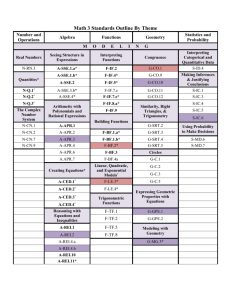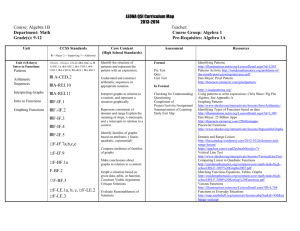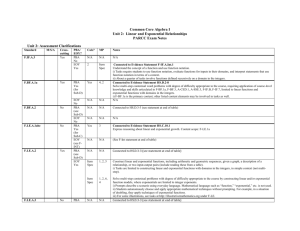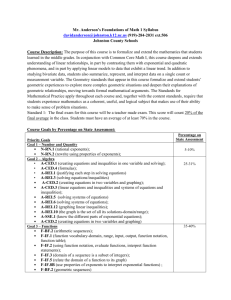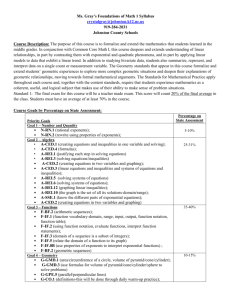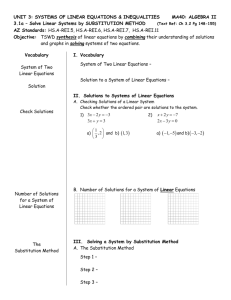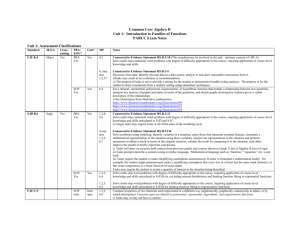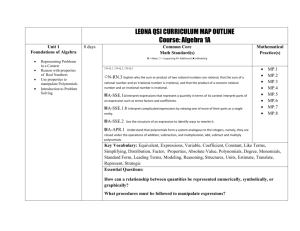04 CC Alg 1 Unit 5 PARCC info
advertisement
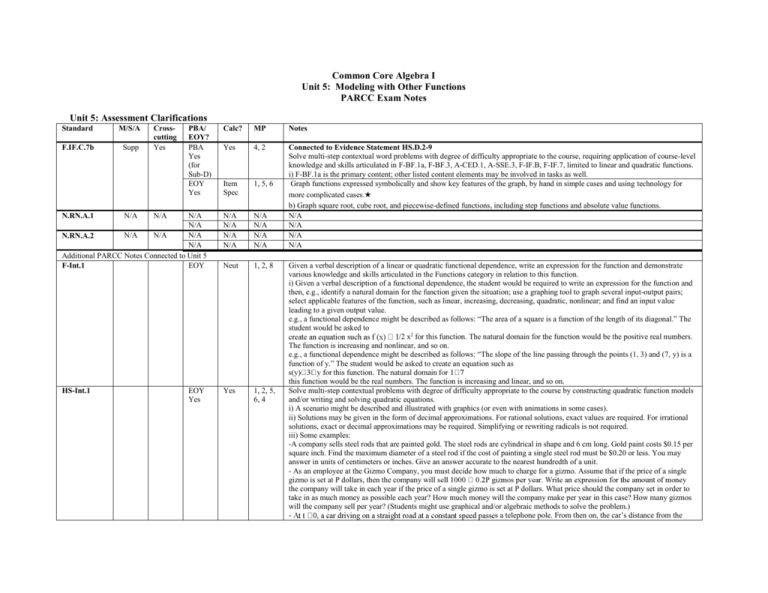
Common Core Algebra I Unit 5: Modeling with Other Functions PARCC Exam Notes Unit 5: Assessment Clarifications Standard M/S/A F.IF.C.7b Supp PBA/ EOY? PBA Yes (for Sub-D) EOY Yes N/A N/A N/A N/A N/A N.RN.A.2 N/A Additional PARCC Notes Connected to Unit 5 EOY F-Int.1 N.RN.A.1 HS-Int.1 N/A Crosscutting Yes N/A EOY Yes Calc? MP Notes Yes 4, 2 Item Spec 1, 5, 6 N/A N/A N/A N/A N/A N/A N/A N/A Connected to Evidence Statement HS.D.2-9 Solve multi-step contextual word problems with degree of difficulty appropriate to the course, requiring application of course-level knowledge and skills articulated in F-BF.1a, F-BF.3, A-CED.1, A-SSE.3, F-IF.B, F-IF.7, limited to linear and quadratic functions. i) F-BF.1a is the primary content; other listed content elements may be involved in tasks as well. Graph functions expressed symbolically and show key features of the graph, by hand in simple cases and using technology for more complicated cases.★ b) Graph square root, cube root, and piecewise-defined functions, including step functions and absolute value functions. N/A N/A N/A N/A Neut 1, 2, 8 Yes 1, 2, 5, 6, 4 Given a verbal description of a linear or quadratic functional dependence, write an expression for the function and demonstrate various knowledge and skills articulated in the Functions category in relation to this function. i) Given a verbal description of a functional dependence, the student would be required to write an expression for the function and then, e.g., identify a natural domain for the function given the situation; use a graphing tool to graph several input-output pairs; select applicable features of the function, such as linear, increasing, decreasing, quadratic, nonlinear; and find an input value leading to a given output value. e.g., a functional dependence might be described as follows: “The area of a square is a function of the length of its diagonal.” The student would be asked to /2 x2 for this function. The natural domain for the function would be the positive real numbers. The function is increasing and nonlinear, and so on. e.g., a functional dependence might be described as follows: “The slope of the line passing through the points (1, 3) and (7, y) is a function of y.” The student would be asked to create an equation such as this function. The natural domain this function would be the real numbers. The function is increasing and linear, and so on. Solve multi-step contextual problems with degree of difficulty appropriate to the course by constructing quadratic function models and/or writing and solving quadratic equations. i) A scenario might be described and illustrated with graphics (or even with animations in some cases). ii) Solutions may be given in the form of decimal approximations. For rational solutions, exact values are required. For irrational solutions, exact or decimal approximations may be required. Simplifying or rewriting radicals is not required. iii) Some examples: -A company sells steel rods that are painted gold. The steel rods are cylindrical in shape and 6 cm long. Gold paint costs $0.15 per square inch. Find the maximum diameter of a steel rod if the cost of painting a single steel rod must be $0.20 or less. You may answer in units of centimeters or inches. Give an answer accurate to the nearest hundredth of a unit. - As an employee at the Gizmo Company, you must decide how much to charge for a gizmo. Assume that if the price of a single gizmo is set at P dollars, then the company will the company will take in each year if the price of a single gizmo is set at P dollars. What price should the company set in order to take in as much money as possible each year? How much money will the company make per year in this case? How many gizmos will the company sell per year? (Students might use graphical and/or algebraic methods to solve the problem.) s a telephone pole. From then on, the car’s distance from the he road, driving in the same direction, initially 90 m ahead of the car. From then on, the motorcycle’s distance from the telephone pole is t is in seconds and M is in meters. At what time t does the car catch up to the motorcycle? Find the answer by setting C and M equal. How far are the car and the motorcycle from the telephone pole when this happens? (Students might use graphical and/or algebraic methods to solve the problem.) Solve multi-step contextual word problems with degree of difficulty appropriate to the course, requiring application of course-level knowledge and skills articulated in F-LE, A-CED.1, A-SSE.3, F-IF.B, F-IF.7, limited to linear functions and exponential functions with domains in the integers. i) F-LE is the primary content and at least one of the other listed content elements will be involved in tasks as well. Solve multi-step contextual word problems with degree of difficulty appropriate to the course, requiring application of course-level knowledge and skills articulated in F-LE, A-CED.1, A-SSE.3, F-IF.B, F-IF.7, limited to linear and quadratic functions. i) F-LE is the primary content and at least one of the other listed content elements will be involved in tasks as well. For rational solutions, exact values are required. For irrational solutions, exact or decimal approximations may be required. Simplifying or rewriting radicals is not required. HS-Int.3-1 EOY Yes Yes 4, 2 HS-Int.3-2 EOY Yes Yes 4, 2 PBA/ EOY? PBA Yes (for Sub-D) Calc? MP Notes Yes 4, 2 Connected to Evidence Statement HS.D.2-5 Solve multi-step contextual word problems with degree of difficulty appropriate to the course, requiring application of course-level knowledge and skills articulated in A-CED, N-Q, A-SSE.3, A-REI.6, A-REI.12, A-REI.11-2, limited to linear equations and exponential equations with integer exponents. i) A-CED is the primary content; other listed content elements may be involved in tasks as well. Yes 4, 2 N/A N/A Connected to Evidence Statement HS.D.2-6 Solve multi-step contextual word problems with degree of difficulty appropriate to the course, requiring application of course-level knowledge and skills articulated in A-CED, N-Q.2, A-SSE.3, A-REI.6, A-REI.12, A-REI.11-2, limited to linear and quadratic functions. i) A-CED is the primary content; other listed content elements may be involved in tasks as well. N/A Yes 4, 2 Connected to Evidence Statement HS.D.2-5 Solve multi-step contextual word problems with degree of difficulty appropriate to the course, requiring application of course-level knowledge and skills articulated in A-CED, N-Q, A-SSE.3, A-REI.6, A-REI.12, A-REI.11-2, limited to linear equations and exponential equations with integer exponents. i) A-CED is the primary content; other listed content elements may be involved in tasks as well. Yes 4, 2 N/A N/A Connected to Evidence Statement HS.D.2-6 Solve multi-step contextual word problems with degree of difficulty appropriate to the course, requiring application of course-level knowledge and skills articulated in A-CED, N-Q.2, A-SSE.3, A-REI.6, A-REI.12, A-REI.11-2, limited to linear and quadratic functions. i) A-CED is the primary content; other listed content elements may be involved in tasks as well. N/A Yes 4, 2 Overarching Standards: Standard M/S/A N.Q.A.1 S N.Q.A.2 N.Q.A.3 S S Crosscutting No Yes No EOY No PBA Yes (for Sub-D) EOY No PBA Yes (for Sub-D) Connected to Evidence Statement HS.D.2-5 Solve multi-step contextual word problems with degree of difficulty appropriate to the course, requiring application of course-level knowledge and skills articulated in A-CED, N-Q, A-SSE.3, A-REI.6, A-REI.12, A-REI.11-2, limited to linear equations and exponential equations with integer exponents. i) A-CED is the primary content; other listed content elements may be involved in tasks as well. EOY No Yes 4, 2 N/A N/A Connected to Evidence Statement HS.D.2-6 Solve multi-step contextual word problems with degree of difficulty appropriate to the course, requiring application of course-level knowledge and skills articulated in A-CED, N-Q.2, A-SSE.3, A-REI.6, A-REI.12, A-REI.11-2, limited to linear and quadratic functions. i) A-CED is the primary content; other listed content elements may be involved in tasks as well. N/A PARCC Abbreviation Key: PBA: Performance-Based Assessment EOY: End of Year Assessment M/S/A: Indicates whether this standard is considered Major content, Supporting Content, or Additional Content MP: Standards for Mathematical Practice * Indicates a modeling standard PARCC Sub-Claims: Sub-Claim A: Information on how PARCC will assess major content Sub-Claim B: Information on how PARCC will assess additional and supporting content Sub-Claim C: Information on how PARCC will assess reasoning Sub-Claim D: Information on how PARCC will assess modeling

